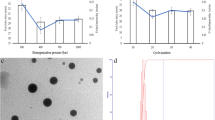Abstract
Aspirin possesses antipyretic, anti-inflammatory, analgesic and anti-aggregatory activity. The acetylsalicylic acid molecule has a carboxyl group and an ester group. The ester group can be easily hydrolyzed, which reduces the medicinal value and causes side effects on humans. The aim of the present study was to prepare solid complexes between aspirin and humic by lyophilization and solvent evaporation technique in the molar ratio 1:1 and 1:2. Molecular interaction between aspirin and humic acid were studied by DSC, XRD, FT-IR and scanning electron microscopy. This technique clearly demonstrated the existence of solid inclusion complex formation. The lyophilized complex in the molar ratio 1:2 showed enhanced stability and dissolution rates of aspirin significantly. A highly significant (p < 0.05) anti-inflammatory action of the treatment of optimized freeze dried (1:2) aspirin complex with humic acid was evidenced by inhibition of rat paw edema and anti-ulcerogenic action was measured by lowest score (0.63 ± 0.10) with significant reduction in ulceration as compared to aspirin alone.







Similar content being viewed by others
References
Frawley, D., Lad, V.: The Yoga of Herbs, 2nd edn, p. 250. Lotus Press, Twin Lakes (2001)
Chopra, R.A., Chopra, I.C., Handa, K.L.: Indigenous Drugs of India, pp. 457–461. U.N. Dhar and Sons, Calcutta (1958)
Ghosal, S.: Shilalit: its origin and significance. Indian J. Indig. Med. 9, 1–3 (1992)
Agarwal, S.P., Aqil, M., Anwer, M.K.: Enhancement of the dissolution and diuretic effect of furosemide through a novel complexation with humic acid extracted from shilajit. Asian J. Chem. 19, 4711–4718 (2007)
Khanna, R., Witt, M., Anwer, M.K., Agarwal, S.P., Koch, B.P.: Spectroscopic characterization of fulvic acids extracted from the rock exudate shilajit. Org. Geochem. 39, 1719–1724 (2008)
Ghosal, S.: Shilajit in Perspective, pp. 1–8. Narosa Publishing, New Delhi (2006)
Agarwal, S.P., Khanna, R., Karmarkar, R., Anwer, M.K., Khar, R.: Shilajit: A Review. Phytother. Res. 21, 401–405 (2007)
Ghosal, S., Singh, S.K., Kumar, Y., Srivastava, R.S., Goel, R.K., Dey, R., Bhattacharya, S.K.: Shilajit: Part 3. Anti-ulcerogenic activity of fulvic acids and 4-methoxy-6-carbomethoxybiphenyl isolated from shilajit. Phytother. Res. 2, 187–191 (1988)
Ghosal, S., Singh, S.K., Srivastava, R.S.: Shilajit: Part 2. Biphenyl metabolites from Trifolium repens. J. Chem. Res. 5, 196–197 (1988)
Ghosal, S.: Delivery system for pharmaceutical, nutritional and cosmetic ingredients. US Patent 6,558,712, 2003
Agarwal, S.P., Aqil, M., Anwer, M.K.: Complexation of furosemide with fulvic acid extracted from shilajit: a novel approach. Drug Dev. Ind. Pharm. 34, 506–511 (2008)
Khanna, R.: Bioenhancers from natural sources. Ph.D Thesis, Jamia Hamdard, New Delhi (2006)
Karmarkar, R.R.: New bioavailability enhancers from natural sources. Ph.D Thesis, Jamia Hamdard, New Delhi (2007)
Chang, R.K., Whitworth, C.W.: Aspirin degradation in mixed polar solvents. Drug Dev. Ind. Pharm. 10, 515–526 (1984)
Gore, A.Y., Maik, K.B., Kildsig, D.O., Peck, G.E., Smolen, V.F., Banker, G.S.: Significance of salicylic acid sublimation in stability testing of aspirin-containing solids. J. Pharm. Sci. 57, 1850–1854 (1968)
Mario, E., Gerraughty, R.J.: Effect of ultrasound energy on hydrolysis of aspirin. J. Pharm. Sci. 54, 321–323 (1965)
Ghosal, S.: In: Vohara, S.B., Dandiya, P.C. (eds.) Research and Development of Indigenous Drugs, pp. 72–80. Institute of History of Medicine and Medical Research, New Delhi (1989)
Choi, H.S.: Molecular inclusion complexes: cyclodextrins and benzaldehyde; cyclodextrins and acetylsalicylic acid. Ph.D Thesis, Purdue University, WL, IN, USA (1989)
Shay, H., Komarow, S.A., Fels, S.S., Meranze, D., Gruenstein, M., Siplet, H.A.: Simple method for the uniform production of gastric ulceration in the rat. Gastroenterology 5, 43 (1945)
Takagi, K., Okabe, S.: Prevention of gastric lesions. US Patent 3,988,466, 1976
Author information
Authors and Affiliations
Corresponding author
Rights and permissions
About this article
Cite this article
Anwer, M.K., Agarwal, S.P., Ali, A. et al. Molecular complexes of aspirin with humic acid extracted from shilajit and their characterization. J Incl Phenom Macrocycl Chem 67, 209–215 (2010). https://doi.org/10.1007/s10847-009-9699-2
Received:
Accepted:
Published:
Issue Date:
DOI: https://doi.org/10.1007/s10847-009-9699-2



